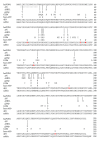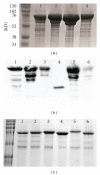Solubilization and humanization of paraoxonase-1
- PMID: 22720164
- PMCID: PMC3376767
- DOI: 10.1155/2012/610937
Solubilization and humanization of paraoxonase-1
Abstract
Paraoxonase-1 (PON1) is a serum protein, the activity of which is related to susceptibility to cardiovascular disease and intoxication by organophosphorus (OP) compounds. It may also be involved in innate immunity, and it is a possible lead molecule in the development of a catalytic bioscavenger of OP pesticides and nerve agents. Human PON1 expressed in E. coli is mostly found in the insoluble fraction, which motivated the engineering of soluble variants, such as G2E6, with more than 50 mutations from huPON1. We examined the effect on the solubility, activity, and stability of three sets of mutations designed to solubilize huPON1 with fewer overall changes: deletion of the N-terminal leader, polar mutations in the putative HDL binding site, and selection of the subset of residues that became more polar in going from huPON1 to G2E6. All three sets of mutations increase the solubility of huPON1; the HDL-binding mutant has the largest effect on solubility, but it also decreases the activity and stability the most. Based on the G2E6 polar mutations, we "humanized" an engineered variant of PON1 with high activity against cyclosarin (GF) and found that it was still very active against GF with much greater similarity to the human sequence.
Figures








Similar articles
-
Dramatic differences in organophosphorus hydrolase activity between human and chimeric recombinant mammalian paraoxonase-1 enzymes.Biochemistry. 2009 Nov 3;48(43):10416-22. doi: 10.1021/bi901161b. Biochemistry. 2009. PMID: 19764813 Free PMC article.
-
Assessing protection against OP pesticides and nerve agents provided by wild-type HuPON1 purified from Trichoplusia ni larvae or induced via adenoviral infection.Chem Biol Interact. 2013 Mar 25;203(1):177-80. doi: 10.1016/j.cbi.2012.10.015. Epub 2012 Nov 2. Chem Biol Interact. 2013. PMID: 23123254
-
Exploring the structural and functional stabilities of different paraoxonase-1 formulations through electrophoretic mobilities and enzyme activity parameters under hydrostatic pressure.Biochim Biophys Acta. 2009 Apr;1794(4):680-8. doi: 10.1016/j.bbapap.2009.01.003. Epub 2009 Jan 29. Biochim Biophys Acta. 2009. PMID: 19336040
-
Human paraoxonase: a promising approach for pre-treatment and therapy of organophosphorus poisoning.Toxicology. 2007 Apr 20;233(1-3):47-59. doi: 10.1016/j.tox.2006.08.037. Epub 2006 Sep 3. Toxicology. 2007. PMID: 17007987 Review.
-
Crossroads in the evaluation of paraoxonase 1 for protection against nerve agent and organophosphate toxicity.Toxicol Lett. 2012 Apr 5;210(1):87-94. doi: 10.1016/j.toxlet.2012.01.013. Epub 2012 Jan 25. Toxicol Lett. 2012. PMID: 22301377 Review.
Cited by
-
Characterization of human paraoxonase 1 variants suggest that His residues at 115 and 134 positions are not always needed for the lactonase/arylesterase activities of the enzyme.Protein Sci. 2013 Dec;22(12):1799-807. doi: 10.1002/pro.2380. Epub 2013 Oct 26. Protein Sci. 2013. PMID: 24123308 Free PMC article.
-
Pharmacogenetics of paraoxonase activity: elucidating the role of high-density lipoprotein in disease.Pharmacogenomics. 2013 Sep;14(12):1495-515. doi: 10.2217/pgs.13.147. Pharmacogenomics. 2013. PMID: 24024900 Free PMC article. Review.
-
Protein Design: From the Aspect of Water Solubility and Stability.Chem Rev. 2022 Sep 28;122(18):14085-14179. doi: 10.1021/acs.chemrev.1c00757. Epub 2022 Aug 3. Chem Rev. 2022. PMID: 35921495 Free PMC article. Review.
-
Human paraoxonase 1 as a pharmacologic agent: limitations and perspectives.ScientificWorldJournal. 2014;2014:854391. doi: 10.1155/2014/854391. Epub 2014 Oct 20. ScientificWorldJournal. 2014. PMID: 25386619 Free PMC article. Review.
-
Novel Self-Cleaving Affinity Purification Method for Cellular Membrane-Associated Recombinant Paraoxonase-1 (rePON1) Enzyme.Protein J. 2025 Aug;44(4):341-350. doi: 10.1007/s10930-025-10271-y. Epub 2025 Jun 2. Protein J. 2025. PMID: 40457011 Free PMC article.
References
-
- Draganov DI, La Du BN. Pharmacogenetics of paraoxonases: a brief review. Naunyn-Schmiedeberg’s Archives of Pharmacology. 2004;369(1):78–88. - PubMed
-
- Shih DM, Gu L, Xia YR, et al. Mice lacking serum paraoxonase are susceptible to organophosphate toxicity and atherosclerosis. Nature. 1998;394(6690):284–287. - PubMed
-
- Mackness MI, Mackness B, Durrington PN, Connelly PW, Hegele RA. Paraoxonase: biochemistry, genetics and relationship to plasma lipoproteins. Current Opinion in Lipidology. 1996;7(2):69–76. - PubMed
Grants and funding
LinkOut - more resources
Full Text Sources
Other Literature Sources
Miscellaneous

